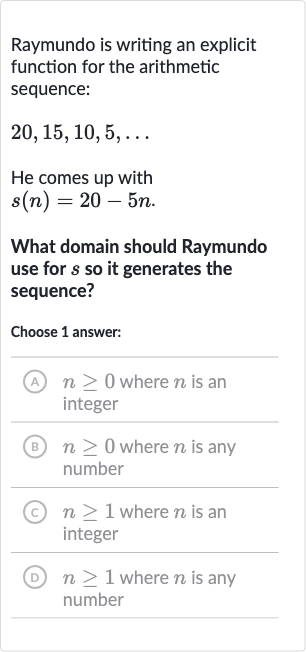AI tutor
Welcome to Bytelearn!
Let’s check out your problem:

Raymundo is writing an explicit function for the arithmetic sequence:He comes up withWhat domain should Raymundo use for so it generates the sequence?Choose answer:(A) where is an integer(B) where is any number(C) where is an integer(D) where is any number
Full solution
Q. Raymundo is writing an explicit function for the arithmetic sequence:He comes up withWhat domain should Raymundo use for so it generates the sequence?Choose answer:(A) where is an integer(B) where is any number(C) where is an integer(D) where is any number
- Consider the arithmetic sequence: Raymundo's function for the arithmetic sequence is . To determine the domain, we need to consider the values of that will generate the sequence and so on. We start by plugging in values of to see if they generate the sequence correctly.
- Test : Let's test to see if it generates the first term of the sequence:However, the first term of the sequence is , not , so does not generate the first term of the sequence. This means that the domain cannot start with .
- Test : Now let's test to see if it generates the first term of the sequence:This is correct, as the first term of the sequence is . Therefore, the domain should include .
- Determine if should be an integer: Next, we need to determine if can be any number or just an integer. Since we are dealing with a sequence, which is a list of numbers in a specific order, should represent the position of a term in the sequence. Positions in a sequence are always whole numbers, so should be an integer.
- Decide the starting value of : Finally, we need to decide if should be greater than or equal to or greater than or equal to
1 1 n = generates the first term of the sequence, the domain should start from0 0 n = .0 0 - Determine the domain: Considering the above steps, the domain should be all non-negative integers starting from
0 0 n ≥ 0 n \geq 0 n n 20 , 15 , 10 , 5 20, 15, 10, 5
More problems from Evaluate recursive formulas for sequences
QuestionGet tutor help
QuestionGet tutor help
QuestionGet tutor help
QuestionGet tutor help
QuestionGet tutor help
QuestionGet tutor help
QuestionGet tutor help
QuestionGet tutor help
